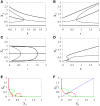Asymmetry in erythroid-myeloid differentiation switch and the role of timing in a binary cell-fate decision
- PMID: 24367366
- PMCID: PMC3851994
- DOI: 10.3389/fimmu.2013.00426
Asymmetry in erythroid-myeloid differentiation switch and the role of timing in a binary cell-fate decision
Abstract
GATA1-PU.1 genetic switch is a paradigmatic genetic switch that governs the differentiation of progenitor cells into two different fates, erythroid and myeloid fates. In terms of dynamical model representation of these fates or lineages corresponds to stable attractor and choosing between the attractors. Small asymmetries and stochasticity intrinsically present in all genetic switches lead to the effect of delayed bifurcation which will change the differentiation result according to the timing of the process and affect the proportion of erythroid versus myeloid cells. We consider the differentiation bifurcation scenario in which there is a symmetry-breaking in the bifurcation diagrams as a result of asymmetry in external signaling. We show that the decision between two alternative cell fates in this structurally symmetric decision circuit can be biased depending on the speed at which the system is forced to go through the decision point. The parameter sweeping speed can also reduce the effect of asymmetry and produce symmetric choice between attractors, or convert the favorable attractor. This conversion may have important contributions to the immune system when the bias is in favor of the attractor which gives rise to non-immune cells.
Keywords: GATA1-PU.1 switch; differentiation; immune cells; pluripotent cells.
Figures











References
Grants and funding
LinkOut - more resources
Full Text Sources
Other Literature Sources

